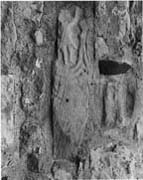Select a site alphabetically from the choices shown in the box below. Alternatively, browse sculptural examples using the Forward/Back buttons.
Chapters for this volume, along with copies of original in-text images, are available here.
Object type: Part of cross-shaft
Measurements: H. 55.5 cm (22 in); W. 14 cm (5.5 in); D. Built in
Stone type: Coarse-grained, massive yellow sandstone
Plate numbers in printed volume: Pl. 30.157
Corpus volume reference: Vol 1 p. 60-61
(There may be more views or larger images available for this item. Click on the thumbnail image to view.)
Probably originally a round-shaft derivative. Only one carved face is visible. Above the plain base the faces have been scalloped into a rectangular form with a double roll moulding at the bottom of the swag. On the one visible face a small figure stands with hand upraised. It wears a knee-length tunic with a scalloped hem.
Although this type of round shaft begins in the pre-Viking period (Collingwood 1927, 6-9), it is most common in the tenth century. The figure carving above the swag is in the Anglo-Scandinavian tradition (see Dinsdale 2 and Finghall, Yorkshire).



